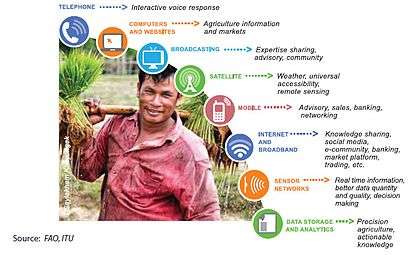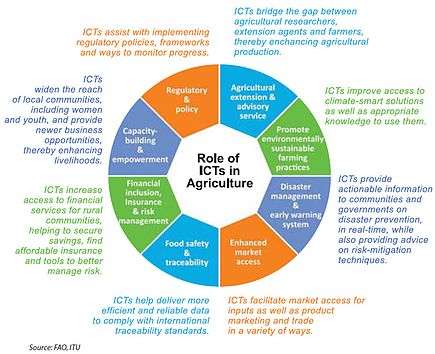Information and communications technology in agriculture
Information and communication technology in agriculture (ICT in agriculture), also known as e-agriculture, is developing and applying innovative ways to use ICTs in the rural domain, with a primary focus on agriculture. ICT in agriculture offers a wide range of solutions to some agricultural challenges. It is seen as an emerging field focusing on the enhancement of agricultural and rural development through improved information and communication processes. In this context, ICT is used as an umbrella term encompassing all information and communication technologies including devices, networks, mobiles, services and applications; these range from innovative Internet-era technologies and sensors to other pre-existing aids such as fixed telephones, televisions, radios and satellites. E-agriculture continues to evolve in scope as new ICT applications continue to be harnessed in the agriculture sector. More specifically, e-agriculture involves the conceptualization, design, development, evaluation and application of innovative ways to use ICTs in the rural domain, with a primary focus on agriculture. Provisions of standards, norms, methodologies, and tools as well as development of individual and institutional capacities, and policy support are all key components of e-agriculture.

E-agriculture is one of the action lines identified in the declaration and plan of action of the World Summit on the Information Society (WSIS). The "Tunis Agenda for the Information Society," published on 18 November 2005 and emphasizes the leading facilitating roles that UN agencies need to play in the implementation of the Geneva Plan of Action. The Food and Agriculture Organization of the United Nations (FAO) has been assigned the responsibility of organizing activities related to the action line under C.7 ICT Applications on E-Agriculture.
Many ICT interventions have been developed and tested around the world, with varied degrees of success, to help agriculturists improve their livelihoods through increased agricultural productivity and incomes, and reduction in risks. Some useful resources for learning about e-agriculture in practice are the World Bank’s e-sourcebook ICT in agriculture – connecting smallholder farmers to knowledge, networks and institutions (2011),[1] ICT uses for inclusive value chains (2013),[2] ICT uses for inclusive value chains (2013)[3] and Success stories on information and communication technologies for agriculture and rural development[4] have documented many cases of use of ICT in agriculture.

The FAO-ITU E-agriculture Strategy Guide[5] was developed by the Food and Agriculture Organization (FAO) and the International Telecommunication Union (ITU) with support from partners including the Technical Centre for Agricultural and Rural Cooperation (CTA) as a framework for countries in developing their national e-agriculture strategy/masterplan.
Some of the countries who are using the FAO-ITU E-agriculture Strategy Guide to develop their national e-agriculture strategy are Bhutan, Sri Lanka, Papua New Guinea, Philippines, Fiji and Vanuatu. The guide provides a framework to engage a broader stakeholders in the development of national e-agriculture strategy.
The main applications of ICT in agriculture sector are listed below.
Wireless technologies
Wireless technologies have numerous applications in agriculture. One major usage is the simplification of closed-circuit television camera systems; the use of wireless communications eliminates the need for the installation of coaxial cables.[6]
Global Positioning System

In agriculture, the use of the Global Positioning System provides benefits in geo-fencing, map-making and surveying. GPS receivers dropped in price over the years, making it more popular for civilian use. With the use of GPS, civilians can produce simple yet highly accurate digitized map without the help of a professional cartographer.
In Kenya, for example, the solution to prevent an elephant bull from wandering into farms and destroying precious crops was to tag the elephant with a device that sends a text message when it crosses a geo-fence. Using the technology of SMS and GPS, the elephant can roam freely and the authorities are alerted whenever it is near the farm.[7]
Geographic information systems
Geographic information systems, or GIS, are extensively used in agriculture, especially in precision farming. Land is mapped digitally, and pertinent geodetic data such as topography and contours are combined with other statistical data for easier analysis of the soil. GIS is used in decision making such as what to plant and where to plant using historical data and sampling.
Computer-controlled devices (automated systems)

Automatic milking systems are computer controlled stand alone systems that milk the dairy cattle without human labor. The complete automation of the milking process is controlled by an agricultural robot, a complex herd management software, and specialized computers. Automatic milking eliminates the farmer from the actual milking process, allowing for more time for supervision of the farm and the herd. Farmers can also improve herd management by using the data gathered by the computer. By analyzing the effect of various animal feeds on milk yield, farmers may adjust accordingly to obtain optimal milk yields. Since the data is available down to individual level, each cow may be tracked and examined, and the farmer may be alerted when there are unusual changes that could mean sickness or injuries.[8]
Smartphone mobile apps in Agriculture
Use of Mobile technologies as a tool of intervention in agriculture is increasingly popular. Smartphone penetration enhance the multi-dimensional positive impact on sustainable poverty reduction and identify accessibility as the main challenge in harnessing the full potential (Silarszky et al., 2008) in agricultural space. Reach of smart phone even in rural areas extended the ICT services beyond simple voice or text messages. Several smartphone apps are available for agriculture, horticulture, animal husbandry and farm machinery.
Smartphone mobile applications designed and developed by Jayalaxmi agrotech Pvt Ltd from India are the most commonly used agriculture apps in India. Their mobile apps are in regional language are designed to break the literacy barrier and deliver the information in most simple manner. Several thousands of farmers across Asia are empowered with these apps.
RFID

The Veterinary Department of Malaysia's Ministry of Agriculture introduced a livestock-tracking program in 2009 to track the estimated 80,000 cattle all across the country. Each cattle is tagged with the use of RFID technology for easier identification, providing access to relevant data such as: bearer's location, name of breeder, origin of livestock, sex, and dates of movement. This program is the first of its kind in Asia, and is expected to increase the competitiveness of Malaysian livestock industry in international markets by satisfying the regulatory requirements of importing countries like United States, Europe and Middle East. Tracking by RFID will also help producers meet the dietary standards by the halal market. The program will also provide improvements in controlling disease outbreaks in livestock.[9][10]
Knowledge management systems
Agrowtube hosts Agriculture only information, best practices, research and success stories videos.
E-learning
E-commerce
Online purchasing order of agri-inputs and agri-equipments. E-commerce
Agricultural resources and services management
Agricultural resources and services management
Computer-aided manufacturing
Computer-aided manufacturing (CAM)
Computer-aided design
Computer-aided design (CAD)
References
- ↑ "World Bank's e-sourcebook ICT in agriculture – connecting smallholder farmers to knowledge, networks and institutions (2011)". World Bank. 20 May 2015. Retrieved 9 June 2016.
- ↑ "ICT uses for inclusive value chains (2013)" (PDF). FAO. 20 May 2015. Retrieved 9 June 2016.
- ↑ "Information and communication technologies for sustainable agriculture (2013)" (PDF). FAO. 20 May 2015. Retrieved 9 June 2016.
- ↑ "Success stories on information and communication technologies for agriculture and rural development" (PDF). FAO. 20 May 2015. Retrieved 9 June 2016.
- ↑ "FAO-ITU E-agriculture Strategy Guide" (PDF). FAO. 20 May 2016. Retrieved 9 June 2016.
- ↑ "Wireless Camera Systems". AgriCamera. Retrieved 14 March 2013.
- ↑ "Kenya Uses Text Messages To Track Elephant". CBS News. 11 February 2009. Retrieved 15 March 2013.
- ↑ "EU-Project Automatic milking". Wageningen UR. 20 February 2008. Retrieved 15 March 2013.
- ↑ "Malaysia begins RFID-enabled livestock tracking program". RFIDNews. 6 April 2009. Retrieved 15 March 2013.
- ↑ Sebastian, Richard (7 June 2010). "RFID in Malaysia – Tracing the ROI". Frost & Sullivan. Retrieved 15 March 2013.
External links
- www.e-agriculture.org - A Community of Practice was set up in 2007 to discuss and share lessons learned regarding the use of ICT to enhance sustainable agricultural development and food security, with over 6,000 members as of 2012, with membership coming from over 150 countries. Members include practitioners, policymakers, representatives of farmer organizations, researchers, and information and communication specialists involved in agriculture and rural development.
- www.ictforag.org - A USAID portal focused on the use of ICT to enhance agricultural development outcomes, which includes toolkits, papers, resources, and webinar recordings on a wide range of topics related to ICT and agriculture.
- ictupdate.cta.int - A bimonthly magazine site and portal focused on the use of ICT in Agriculture in Africa, the Caribbean and the Pacific region with 100s of articles.